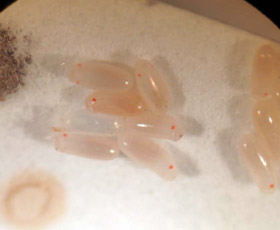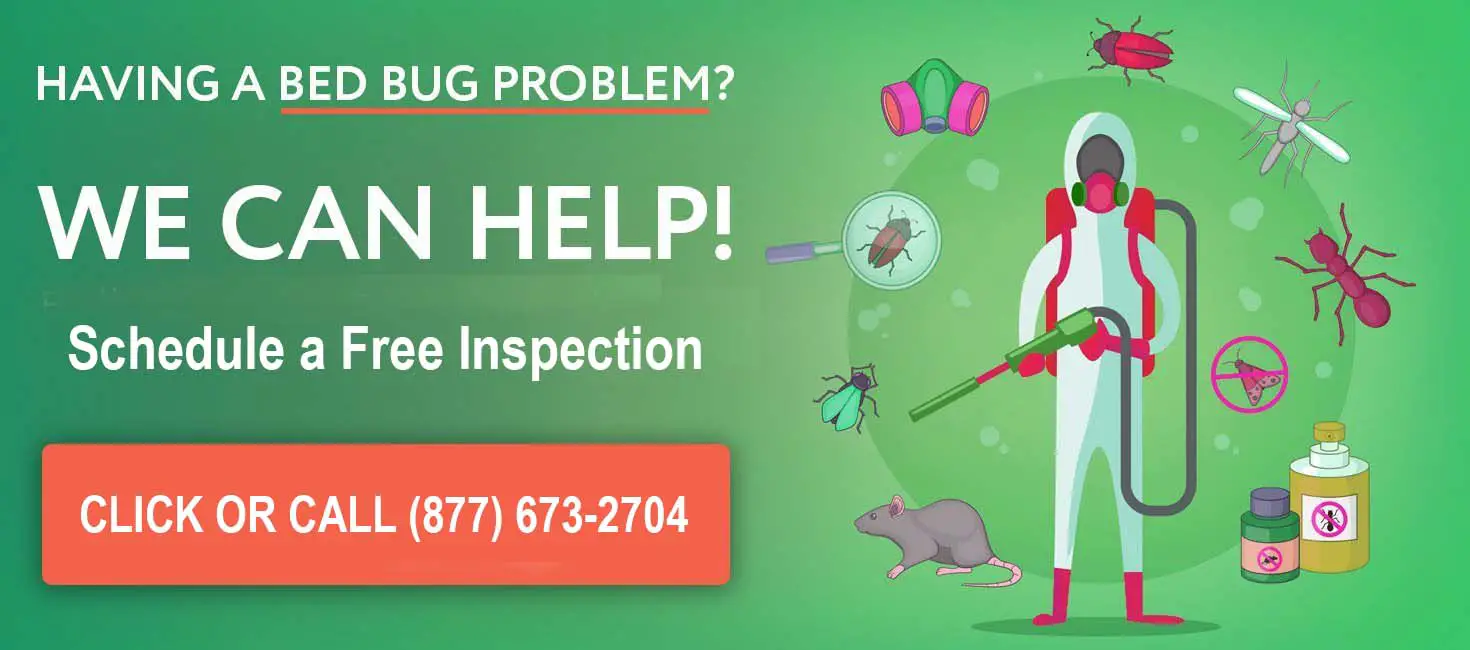Identification and Bed bug egg removal can be easily accomplished with the right tools and methods. Bed bug eggs are small, white, and about the size of the head of a pin (1/32"). They can be seen with the naked eye, but because of the small size they are difficult to find and often require the use of magnification and a flashlight when searching for eggs.
They cannot be picked up with a vacuum as when they are laid, they are sticky and attach to the surface. Most bed bug sprays will kill bedbug eggs on contact (check the label). Since they are easy to miss, a failure to kill bedbug eggs is usually the reason why 2 to 3 treatments are required before a bedbug population is removed from a home.
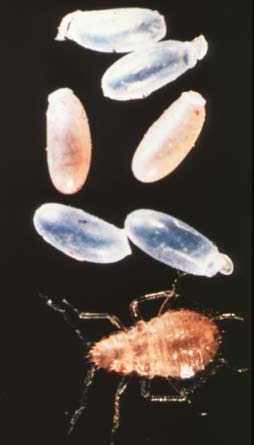 Picture BedBug Egg Next to Nymph (baby bed bug)
Picture BedBug Egg Next to Nymph (baby bed bug)Bed Bug Life cycle
Most eggs hatch (64%) between days 6 or 7 (90% between days 8 and 9), all depending on the temperature.
A bed bug will pass through 5 stages before reaching
adulthood which is the 6th stage of the bedbug life cycle. A newly hatched baby bed bug or nymph is referred to as an instar. An instar needs a blood meal within 3 days or they will start to die, which is thought to be more a factor of dehydration than not having the blood meal. This can happen if the egg is laid far from a host.
The
rate at which bed bugs move through the various life stages depends on
the temperature of the room and the availability of a host. A
bed bug must feed on a human or other warm blooded animal to move to
the next stage. When born, a baby bed bug (instar) can inflict a bed
bug bite in the same manner as an adult. Bed bugs can procreate in as
little as 5 weeks after being born.
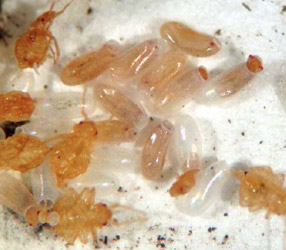 Hatching Bed Bug Nymphs
Hatching Bed Bug NymphsA bed bug can live from 10 months to about a year. Adults can survive for just over a year without a blood meal with baby bed bugs (nymphs) surviving for several months. In favorable temperatures (70F - 80F) bed bugs can completely develop in 30 days and can produce 3+ generations in a year. The population can double in 16 days if the conditions are right.
A female bedbug needs a blood meal before laying eggs. 97% will hatch successfully.
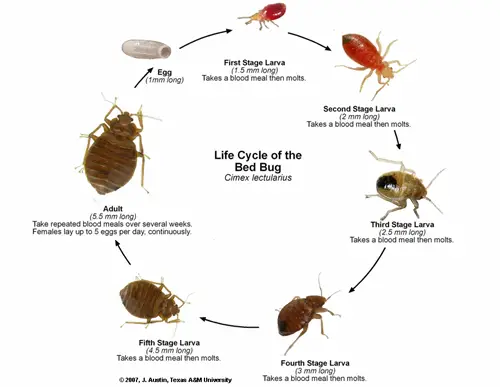 Picture Bed Bug Egg Hatch and Lifecycle
Picture Bed Bug Egg Hatch and Lifecyclebed bug egg biology
A female bed bug will lay 5 to 7 eggs/week, 1 or more eggs
per day and
200-500 eggs over her lifetime. The eggs are small (1 mm, 1/32"),
whitish in
color and slightly pear shaped. Bed bug eggs are difficult to
see without magnification or a flashlight and are about the size of a pin head or speck
of dust.
An egg hatches in 10 days and will develop into an adult in 2 to 4 months.
When laid, the bedbug eggs are sticky, and adhere to the surfaces where they are placed. Eggs are found in harborages where bedbugs hide in loose clusters.
The size of the skin reaction depends on the allergic response of the individual. Hypersensitive individuals will have larger reactions.
Pictures of bed bug eggs
Various bedbug egg pictures are shown below. Given their small size, the eggs are magnified.
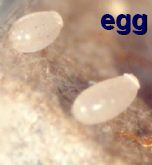 Picture of Bed Bug Eggs on Surface
Picture of Bed Bug Eggs on Surface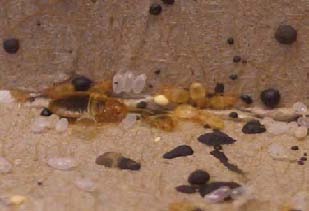 Picture Bed Bug Eggs on Surface
Picture Bed Bug Eggs on Surface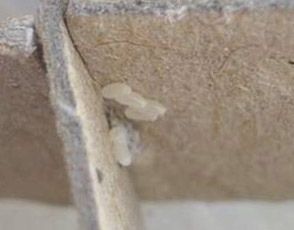 Picture of BedBug Egg Cluster on Surface
Picture of BedBug Egg Cluster on Surfacewhere to find bed bug eggs
Bedbug eggs will be located in locations near the areas where bed bugs hide as indicated in the picture below.
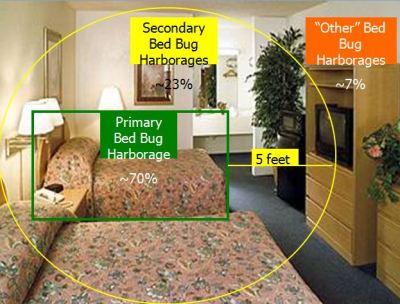 Picture Bed Bug Hiding Places
Picture Bed Bug Hiding PlacesIn advanced cases bed bug skin reactions can turn into blisters.
how to kill bedbug eggs
There are several methods available for killing bed bug eggs. A vacuum will not pick up the eggs since they are stuck to the surface. Effective methods include:
1. Knock Down Bedbug Sprays: There are natural and insecticide sprays that are effective at killing bedbug eggs.
- Insecticide
Based Sprays: Our recommended options are Sterifab
(pump spray, alcohol base plus synthetic pyrethroid), and Bedlam
(aerosol that uses multiple chemicals). Both products have
been independently verified (University of Kentucky Study) for being
able to kill both bed bugs and bed bug eggs on contact. They
both also work on insecticide resistant bedbugs, an important factor in
areas with larger bed bug problems such as New York. Both products are
mattress safe (follow manufacturers directions).
These bed bug sprays are more economically purchased as part of a bed bug kit, which includes the combination of products needed to kill bed bug eggs and bedbugs yourself. - Natural or Organic Bed Bug Sprays: The spray Bed Bug Patrol will kill bed bugs and bed bug eggs. It is manufactured using plant extracts which are known to kill both bed bugs and bedbug eggs on contact. The spray is mattress safe (follow manufacturers directions) and comes from a reputable organic products manufacturer. It is also available as part of a natural bed bug kit.
2. Heat Treatment: Bed bugs and bedbug eggs are killed at 113F. There are several approaches for using heat.
- Steam: A hand held steamer can be used to kill bedbug eggs. The steam is at approximately 250F, more than enough heat to kill bedbugs and bed bug eggs.
- Dry Heat:
Professionals use portable heating units to heat a room to
the required temperatures. All bedbug eggs in the treated
room will be killed.
According to the New York City Department of Health, a home approach is to holding a hair dryer on the hottest setting with the low air setting will generate enough heat when held on a surface for 30 seconds.
A convenient option for home owers is a portable/foldable heating unit called a PackTite. They are designed to hold items such as a suitcase to ensure that no bed bugs or eggs were carried home. It is also the perfect way to treat items found in a home.
3. Wash and Dry Clothes: Washing
clothes in hot water followed by at least 15 minutes in the dryer will
kill all bedbugs and eggs. When moving clothes from an infested area, be sure to carry in a plastic bag tied at the top, or a plastic bin with a snap on lid.
4. Freezing: Eggs will be killed in 10 days in freezing temperatures (some studies show this will occur in as little as 5 days). Also a freezing spray such as a carbon dioxide spray used by professionals will kill bed bugs and eggs immediately.
egg and bed bug removal
A quick home remedy is to use double sided packing tape to remove bedbug eggs. Place the tape on top of the eggs and pull. Dispose in a plastic bag and remove from the home.
Bedbug eggs are usually the reason why bed bug treatments fail.
For this reason, it is preferable to call in a professional
such as a member of the Home Advisor (1.877.233.1145) network. Members are pre-screened and up to
3 free quotes are available for comparison. You can also review the
listings in our bed
bug exterminator database.
If interested in doing it yourself, see our step by step instructions for bed bug removal.
Brochures
Each of these free brochures are filled with additional picture of bed bug bite examples such as photos of rashes, skin reactions, mattress signs and information.
references
University of Kentucky Cooperative Extension
Bed Bugs
Michael F. Potter, Professor and Urban Entomologist
Cornell
Cooperative Extension
Dr. Jody Gangloff-Kaufmann, Jill Shultz
